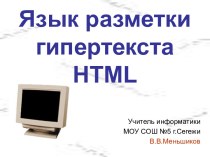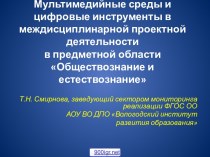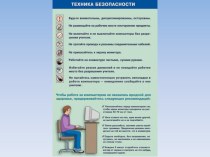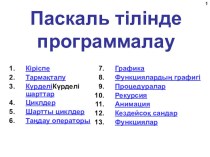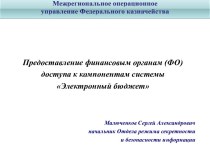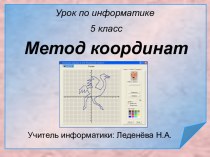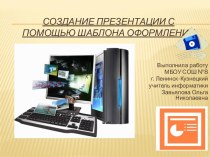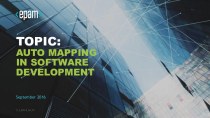- Главная
- Разное
- Бизнес и предпринимательство
- Образование
- Развлечения
- Государство
- Спорт
- Графика
- Культурология
- Еда и кулинария
- Лингвистика
- Религиоведение
- Черчение
- Физкультура
- ИЗО
- Психология
- Социология
- Английский язык
- Астрономия
- Алгебра
- Биология
- География
- Геометрия
- Детские презентации
- Информатика
- История
- Литература
- Маркетинг
- Математика
- Медицина
- Менеджмент
- Музыка
- МХК
- Немецкий язык
- ОБЖ
- Обществознание
- Окружающий мир
- Педагогика
- Русский язык
- Технология
- Физика
- Философия
- Химия
- Шаблоны, картинки для презентаций
- Экология
- Экономика
- Юриспруденция
Что такое findslide.org?
FindSlide.org - это сайт презентаций, докладов, шаблонов в формате PowerPoint.
Обратная связь
Email: Нажмите что бы посмотреть
Презентация на тему Windows XP Embedded Boot Options (Melbourne)
Содержание
- 2. Windows XP Embedded Boot Options (Melbourne)David
- 3. AgendaMicrosoft Windows XP Embedded FeaturesCreating an XP
- 4. Windows XP Embedded Boot OptionsCan boot
- 5. Windows XP Embedded Features
- 6. Thin ClientsNetwork DevicesOffice AutomationKiosk/ATMGame PlatformsIndustrial AutomationRetail Point of SaleSet-Top BoxGateway/Media StoreWhat People Are Building Today
- 7. Componentized version of Windows XP Professional
- 8. Windows XP Embedded Service Pack 2: Changes to the Embedded-enabling Features
- 9. Robust diskless system but want to use
- 10. Creating an XP Embedded Image
- 11. Microsoft Windows Embedded Tools-1Target AnalyserInterrogates target system
- 12. Microsoft Windows Embedded Tools-2Target DesignerSpecify imageWhich platformChoose
- 13. DeploymentSuitably prepare target mediaCreate partition, set as
- 14. Creating an Windows XP Embedded ImageDavid Jones
- 15. Overview of Boot Up
- 16. Boot DevicesNeed to read boot information and
- 17. Classifications of Boot Media Read/Write vs. Read-only
- 18. Read-write and Read-only MediaRead/writeHard driveEmbedded DiskuDoc(Compact Flash)Read-only MediaCompact FlashCD-ROMNetwork
- 19. Removable Vs. Fixed MediaFixed Media:Hard drive, solid-state
- 20. Booting with Windows XP Embedded
- 21. Windows XP Embedded Boot ModesHard driveRead/writeOverlaysHORM.OR Diskless:Solid State DevicesSolid State DiskFlash ROMCompact FlashUSBBootable CDNetwork
- 22. Booting With Windows XP Embedded in 5
- 23. A Typical Boot.ini FileThis will boot Windows
- 24. Hard Drive: Read-write ModeCan build a Windows
- 25. Enhanced Write Filter (EWF) OverviewProtects a
- 26. EWF ModesNote: EWF Volume is created by First Boot Agent for first two modes.
- 27. Disk OverlaysRead OnlyRead OnlyRead/Write by EWFChanges to
- 28. RAM OverlayWhen system is shutdown, overlay in
- 29. RAM Reg OverlayEWF configuration is skipped in
- 30. Note on EWF APIThere is an API
- 31. Booting Windows XP Embedded from a Hard
- 32. Booting Windows XP Embedded from CF
- 33. CF TypesConsumer GradeMeant for use in consumer
- 34. CF IssuesPros and Cons?Solid state? Robust? Removable?
- 35. Using CF in an Embedded SystemCF has
- 36. True IDE Mode: Fixed Disk ModeWhen pin
- 37. CF ScenariosUse an OEM/Industrial grade CFGet utility
- 38. Booting from CF with Windows XP Embedded
- 39. EWF on CF Registry keysWindows Registry Editor Version 5.00[HKEY_LOCAL_MACHINE\SYSTEM\CurrentControlSet\Services\ewf]"ErrorControl"=dword:00000001"Group"="System Bus Extender""Start"=dword:00000000"Type"=dword:00000001[HKEY_LOCAL_MACHINE\SYSTEM\CurrentControlSet\Control\Class\ {71A27CDD-812A-11D0-BEC7-08002BE2092F}]"UpperFilters"="Ewf"[HKEY_LOCAL_MACHINE\SYSTEM\CurrentControlSet\Services\ewf\ Parameters][HKEY_LOCAL_MACHINE\SYSTEM\CurrentControlSet\Services\ewf\ Parameters\Protected][HKEY_LOCAL_MACHINE\SYSTEM\CurrentControlSet\Services\ewf\ Parameters\Protected\Volume0]"VolumeID"="{1EA414D1-6760-4625-8CBE-4F9F85A48E15}""Type"=dword:00000001"ArcName"="multi(0)disk(0)rdisk(0)partition(1)"
- 40. Boot a device in RAM Reg mode
- 41. Booting from Other Devices
- 42. Embedded DisksCan have IDE interfacePlug in in
- 43. Solid State Disk DemosThe previous Disk Overlay
- 44. USBMany embedded SBC only have USB 1.1Not
- 45. USB: M-Systems uDocM-Systems uDoc (USB DiskOnChip)Windows XP
- 46. Windows XP Embedded CD-ROM BootUse RAM Reg
- 47. Booting From CD-ROMSlower boot than solid stateEasy
- 48. Create imageNeed EWF componentsNTLDR, Registry, Management consoleNeed
- 49. Using a pre-existing imageBooting Windows XP Embedded
- 50. Windows XP Embedded HORM BootHibernate Once Resume
- 51. Booting from HORMFast boot of system to
- 52. HORM Boot: How toCreate image. NeedsEWF:RAM Overlay
- 53. HORM: Key IssueThis uses Power Management componentThat
- 54. HORM: Hibernate Once Read ManyBooting a Windows
- 55. Windows XP Embedded (REMOTE) Network BootBoot with
- 56. Remote BootCreate a Windows XP Embedded image
- 57. Remote Boot: How toCreate image and run
- 58. David Jones RMIT University
- 59. HORM: Hibernate Once Read ManyRemote Booting of
- 60. Boot Performance
- 61. UsabilityHow much boot time will users suffer?CF
- 62. Discussion: Collation of Boot Times from Demos as Above
- 63. ConclusionsWindows XP Embedded can be booted from
- 64. Resourceshttp://www.microsoft.com/communities/newsgroups/en-us/default.aspxSearch for "Windows XP Embedded" "General Discussion"
- 65. Resources"Developing Solutions for Microsoft Windows XP Embedded"XPe
- 66. Contact:David JonesRMIT University, Melbourne Victoria, AustraliaSchool of Electrical & Computer Engineeringdavejones@rmit.edu.auhttp://babbage.sece.rmit.edu.au/embedded
- 67. Скачать презентацию
- 68. Похожие презентации


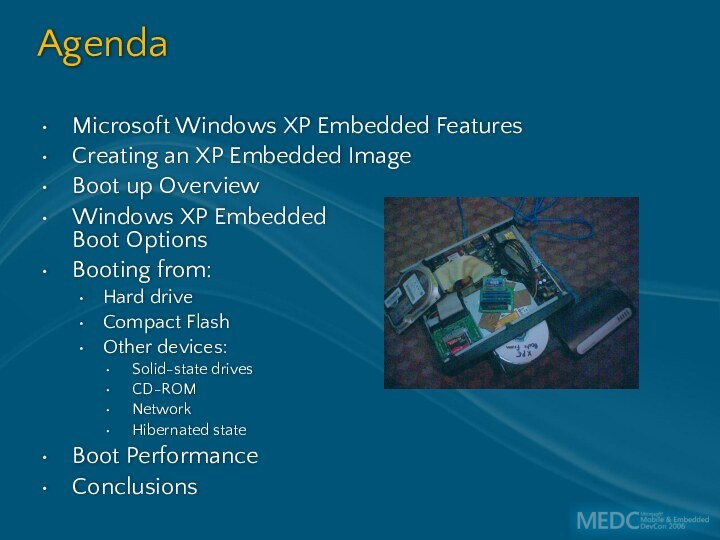




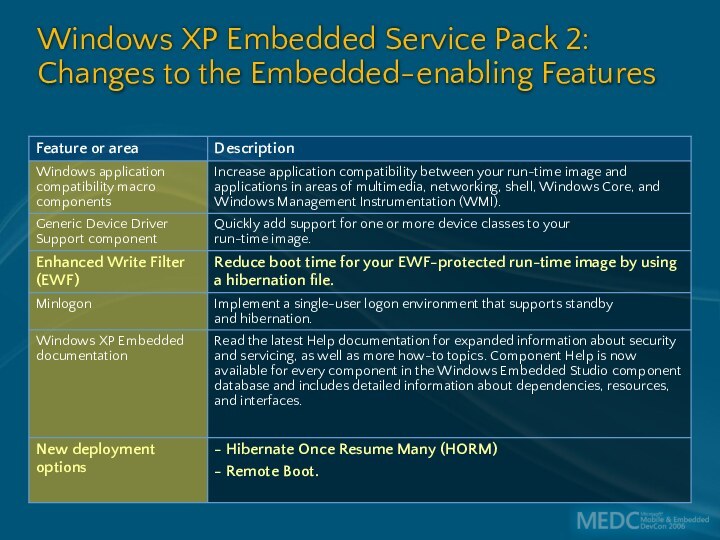
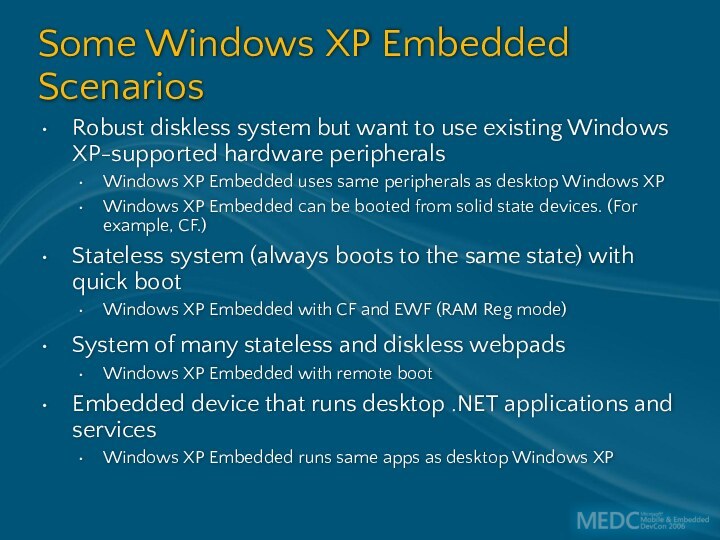
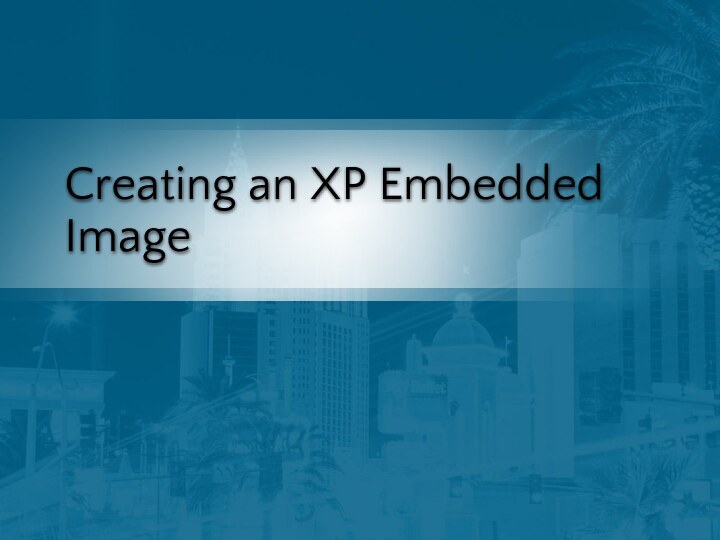
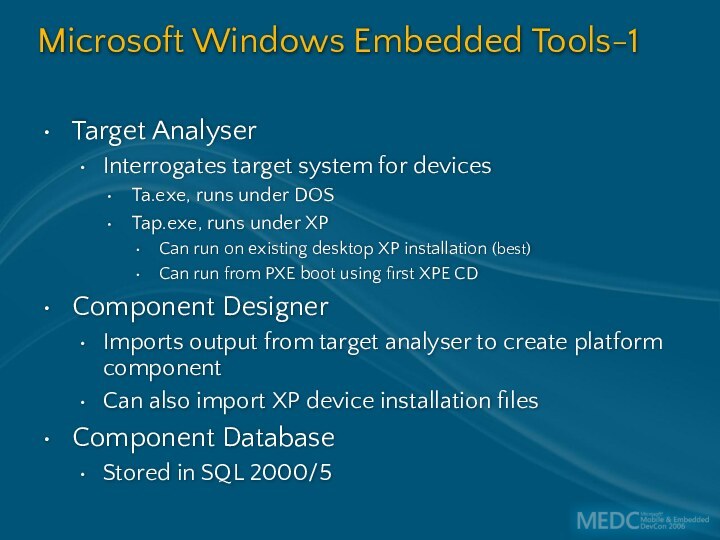
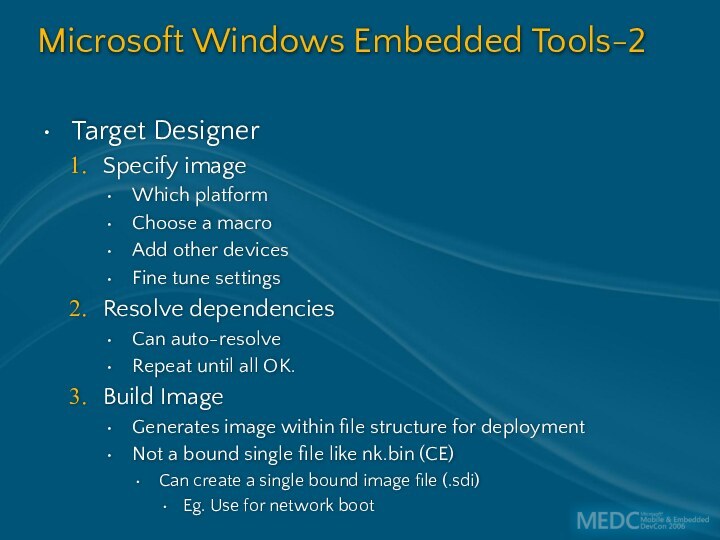
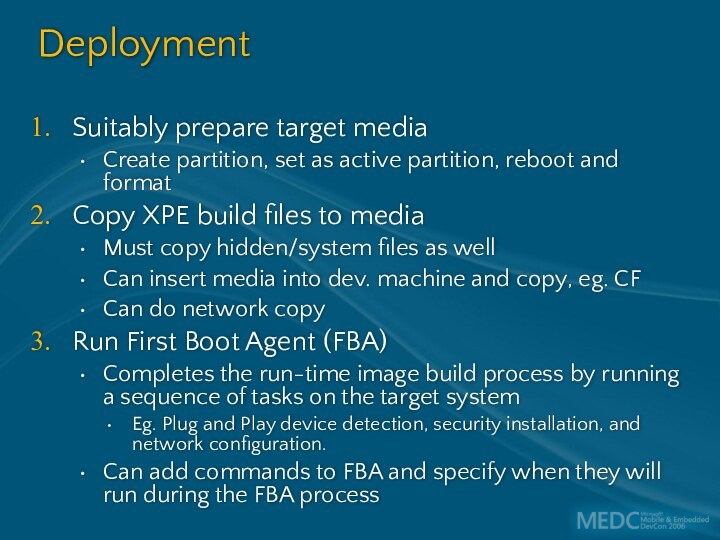
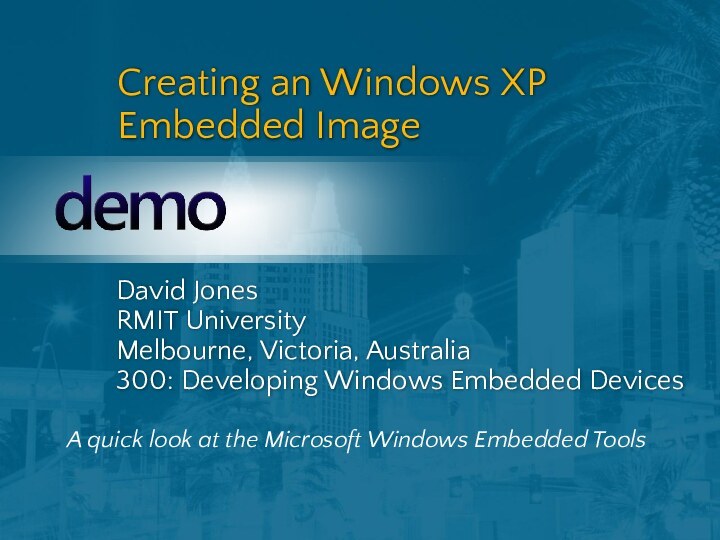
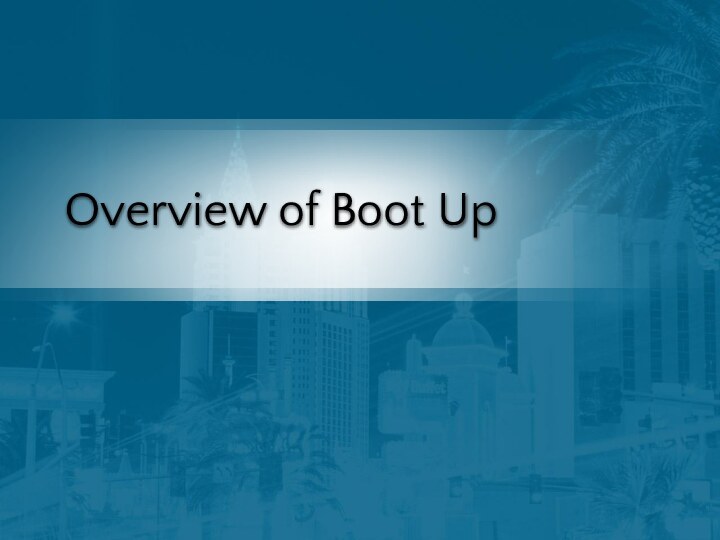
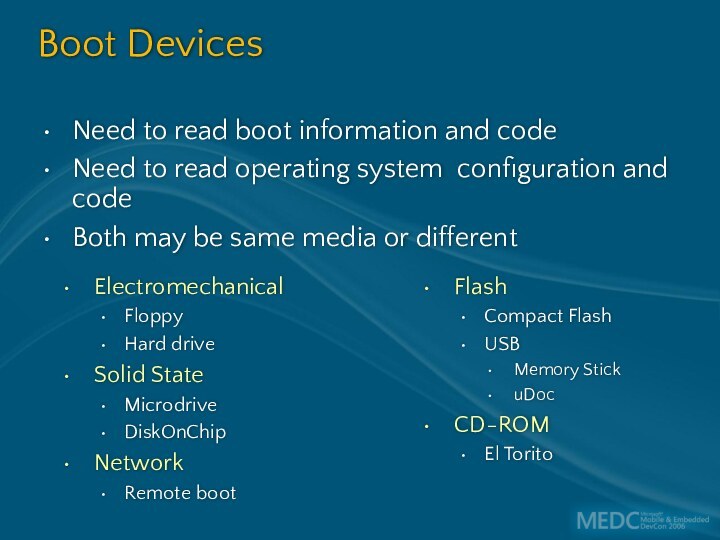

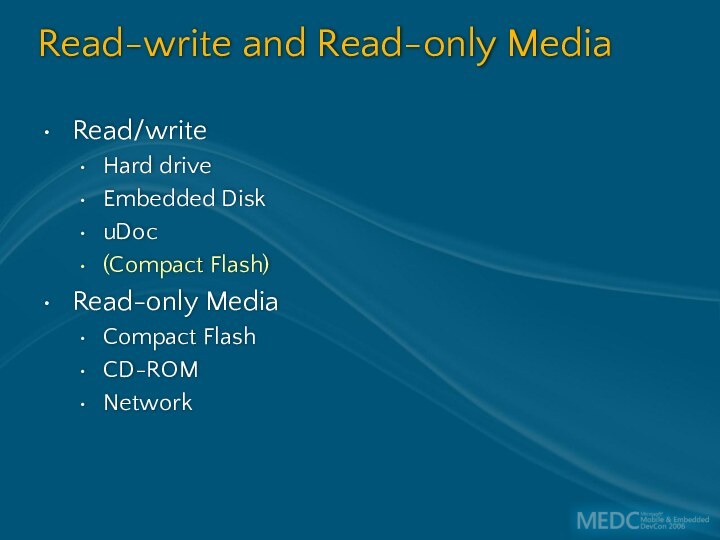
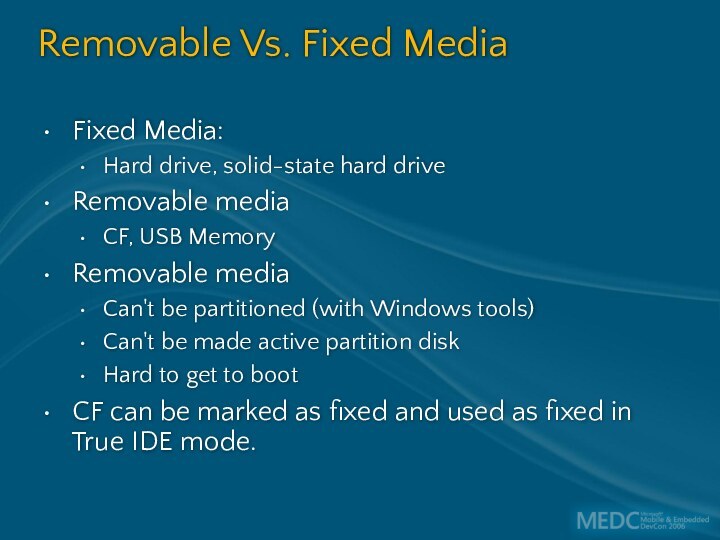
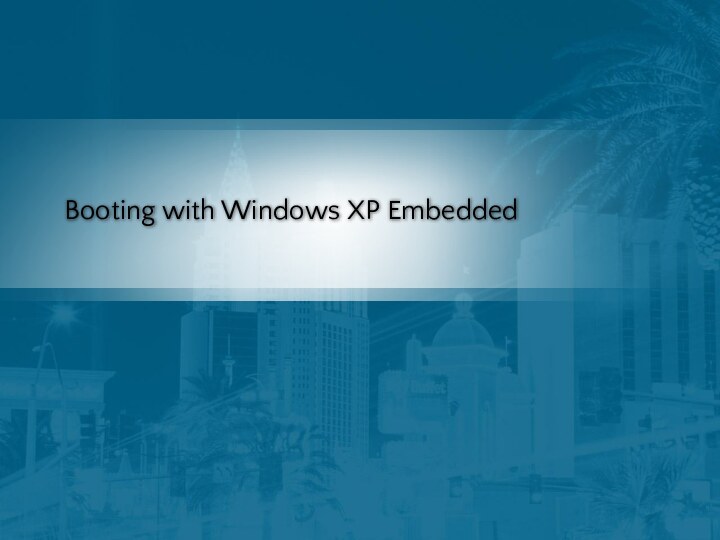
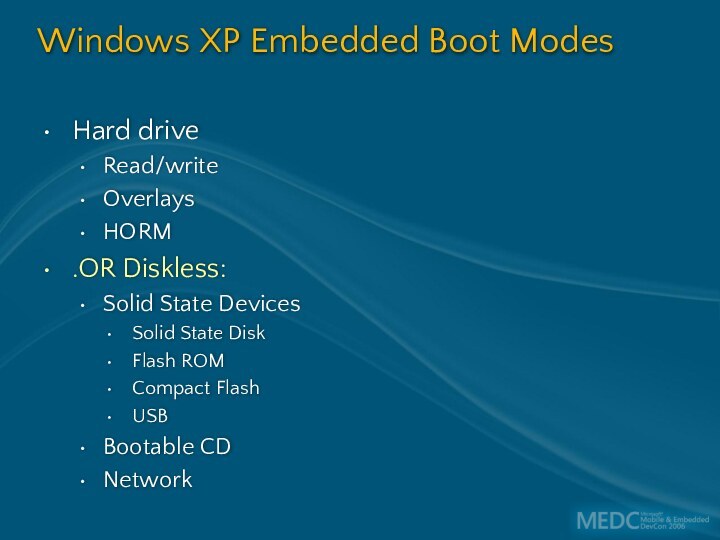
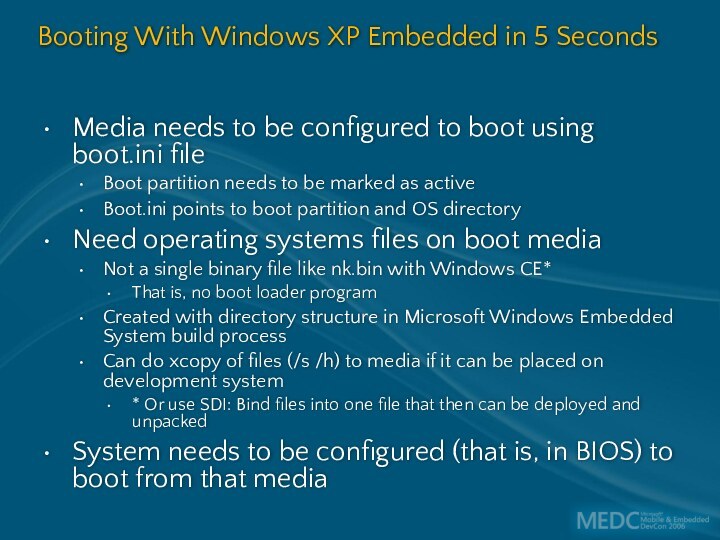
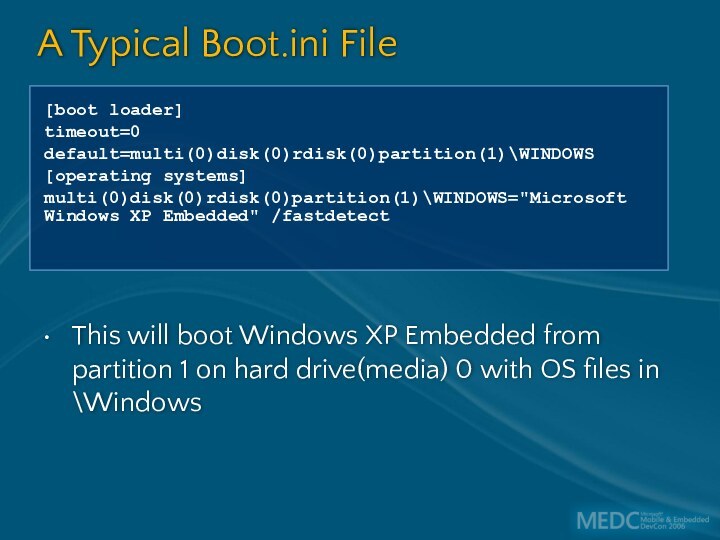
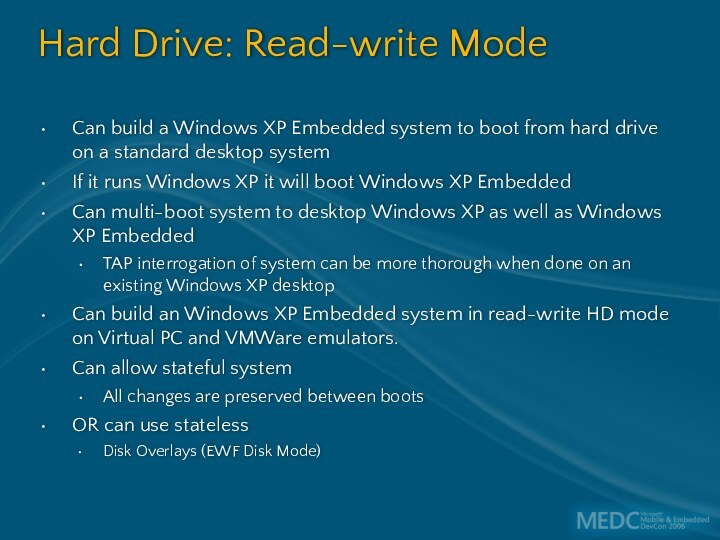


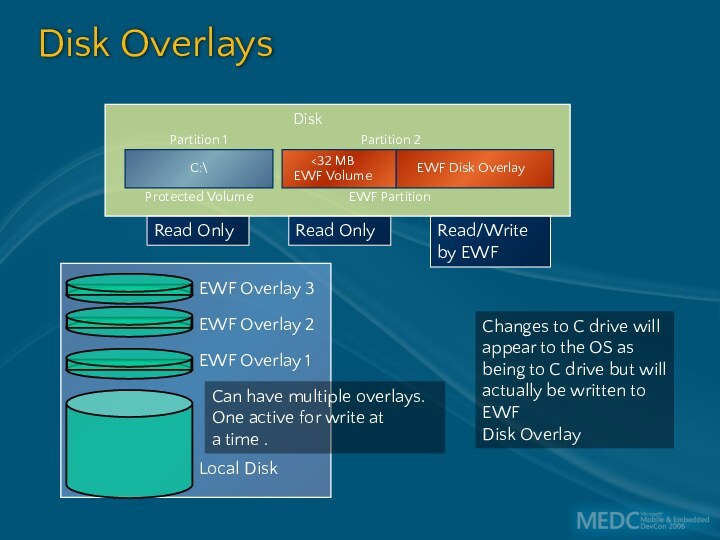
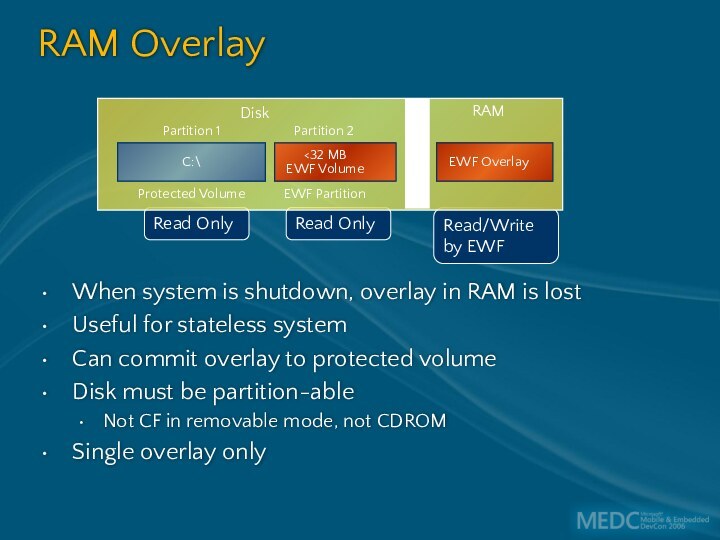

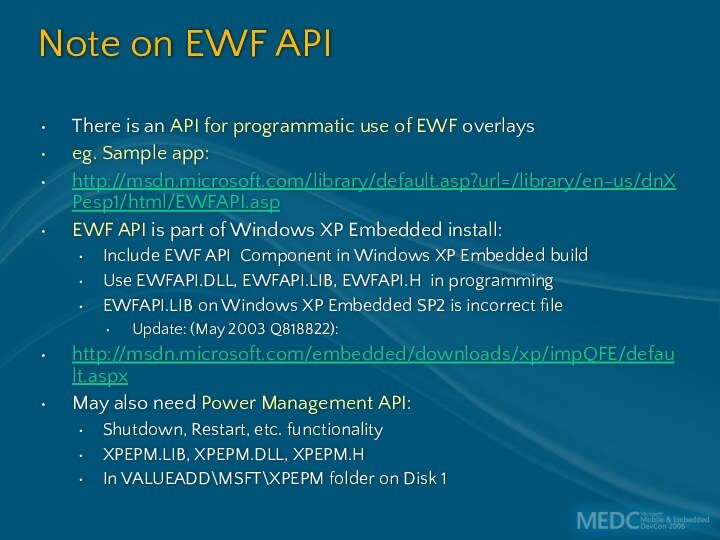
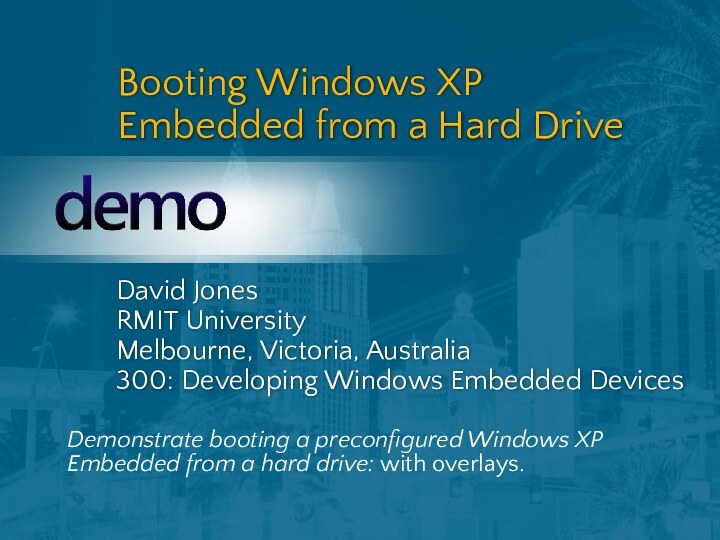

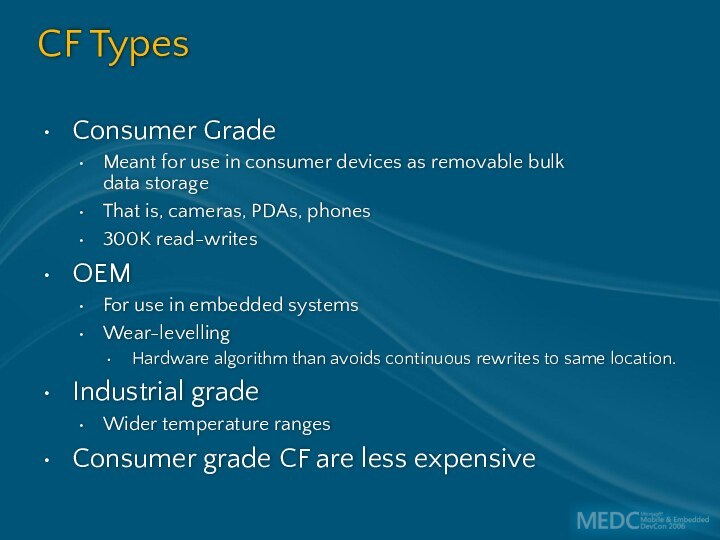
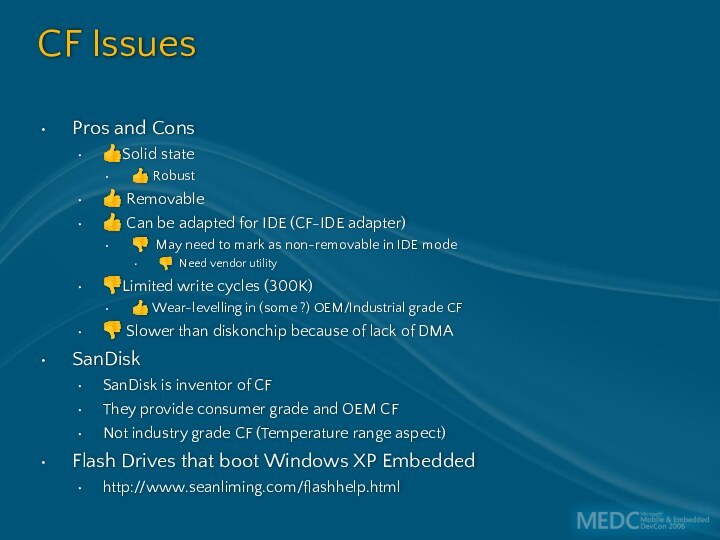
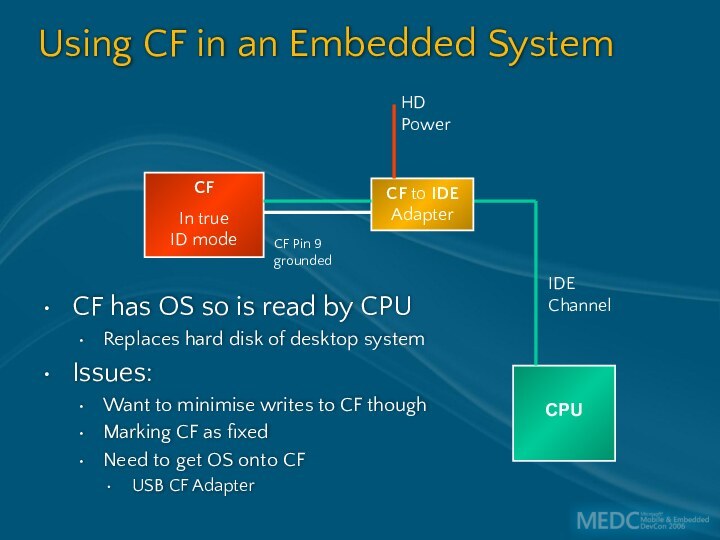
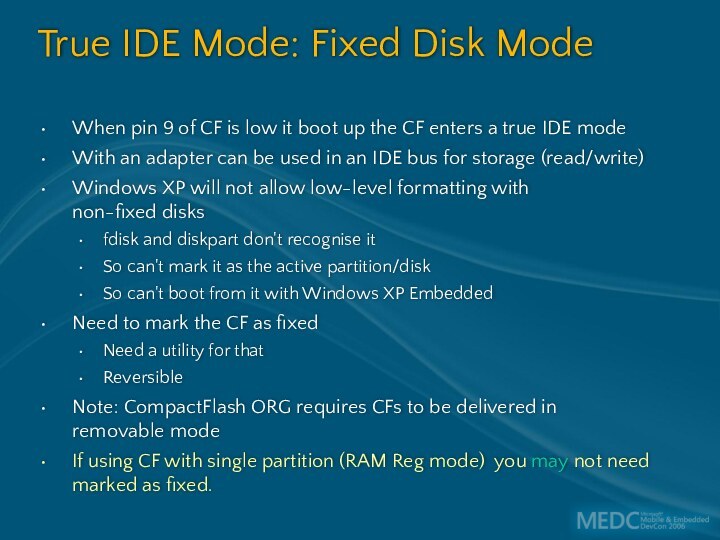
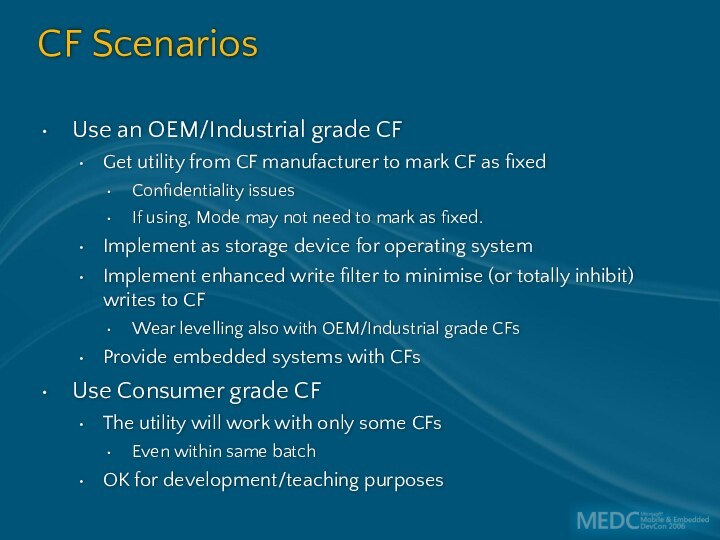

![Windows XP Embedded Boot Options (Melbourne) EWF on CF Registry keysWindows Registry Editor Version 5.00[HKEY_LOCAL_MACHINE\SYSTEM\CurrentControlSet\Services\ewf]](/img/tmb/15/1418623/5ed685cc9f96b34a5921da4b7c930b98-720x.jpg)


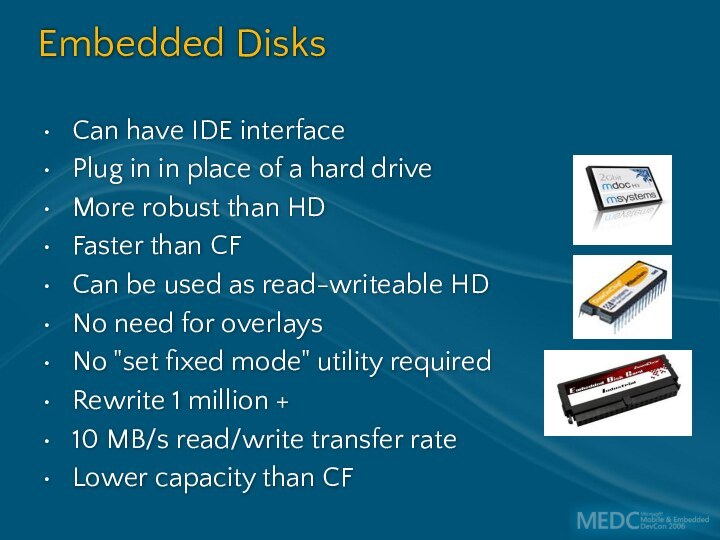
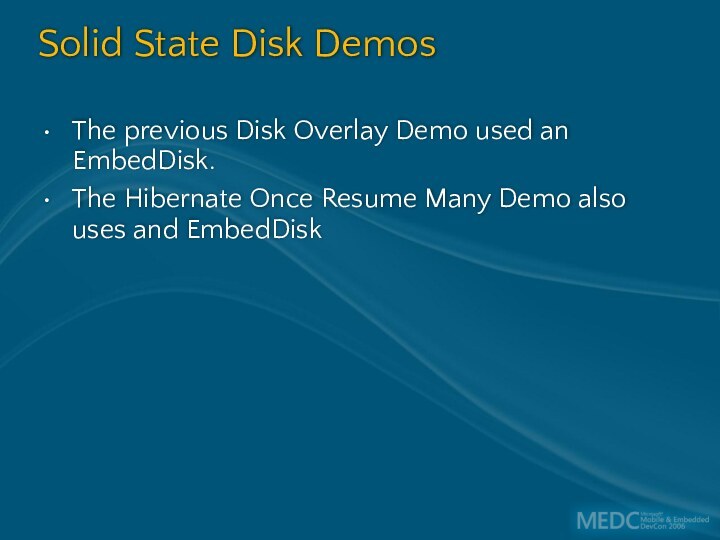
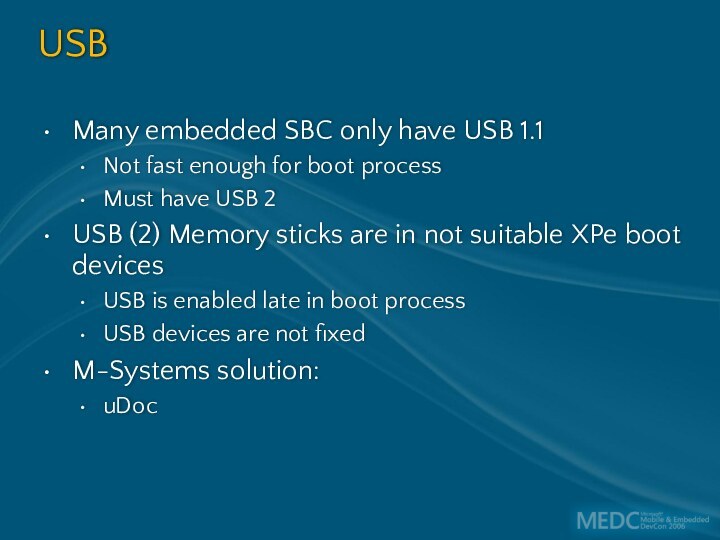
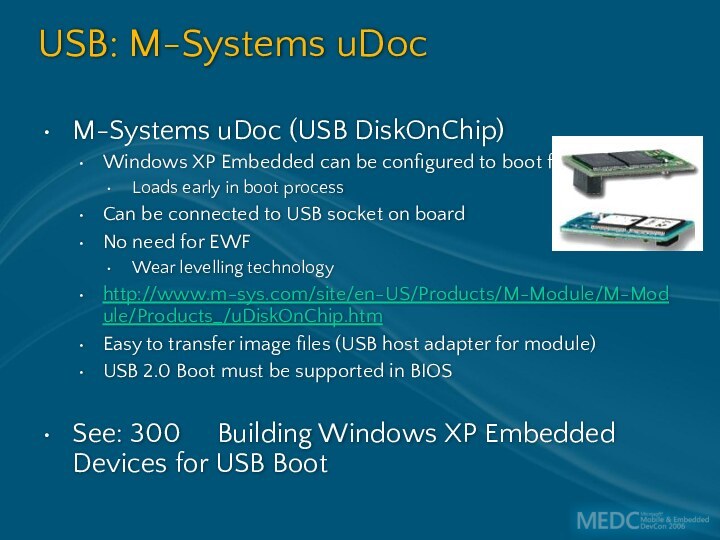
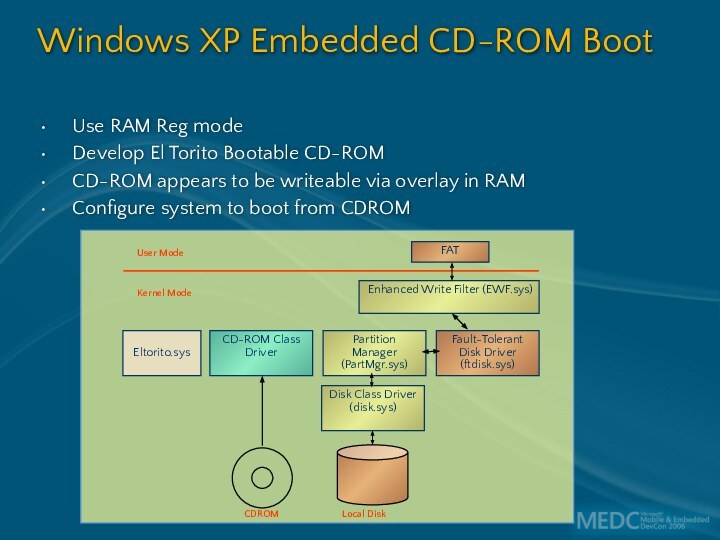

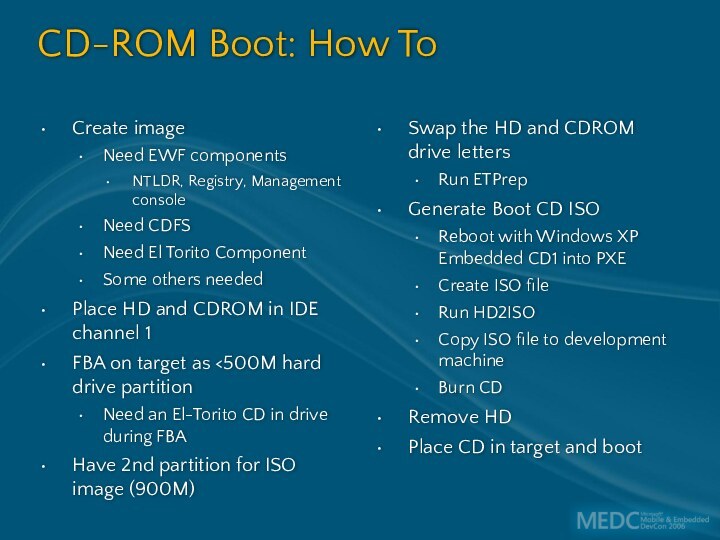
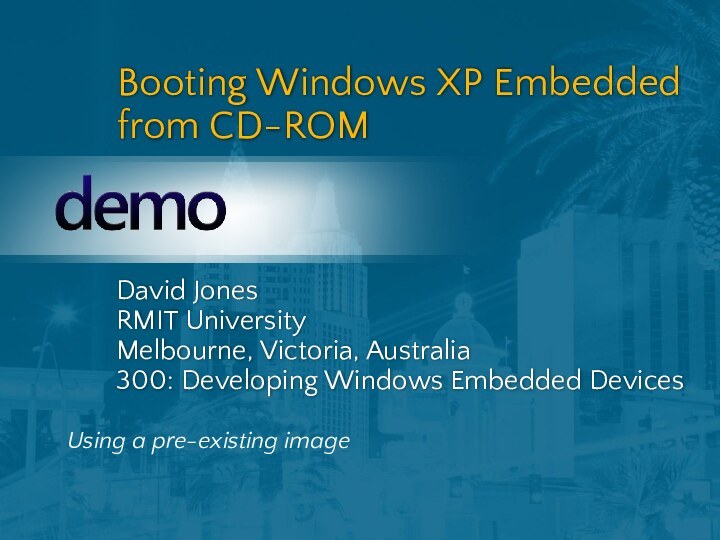





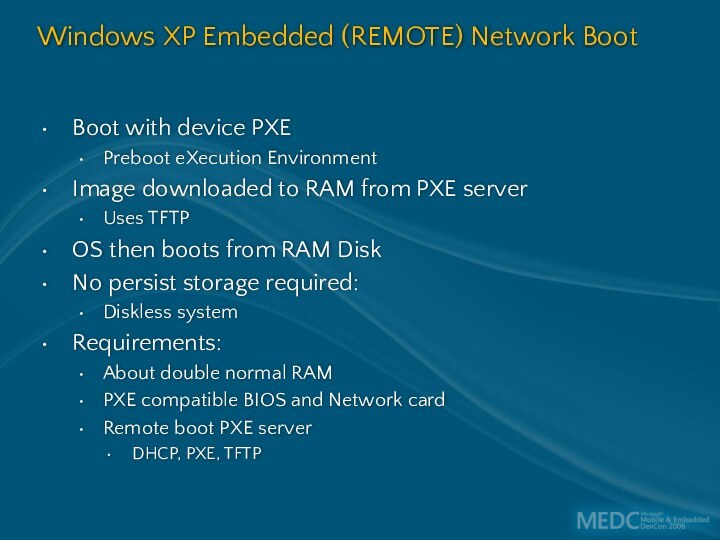
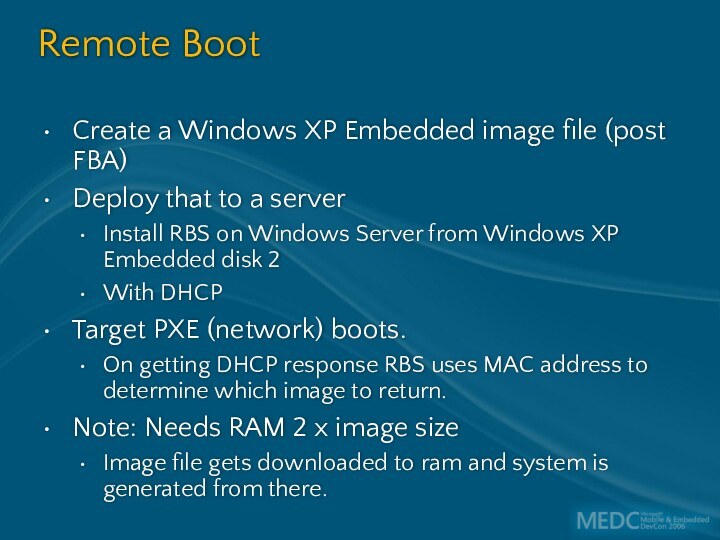






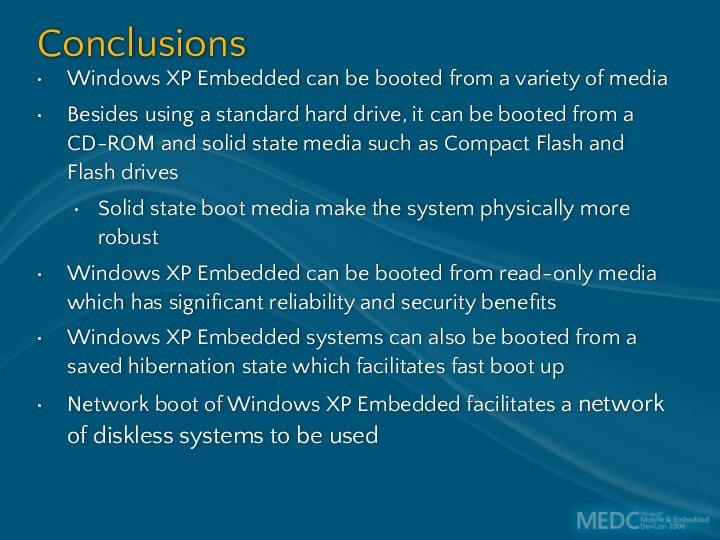

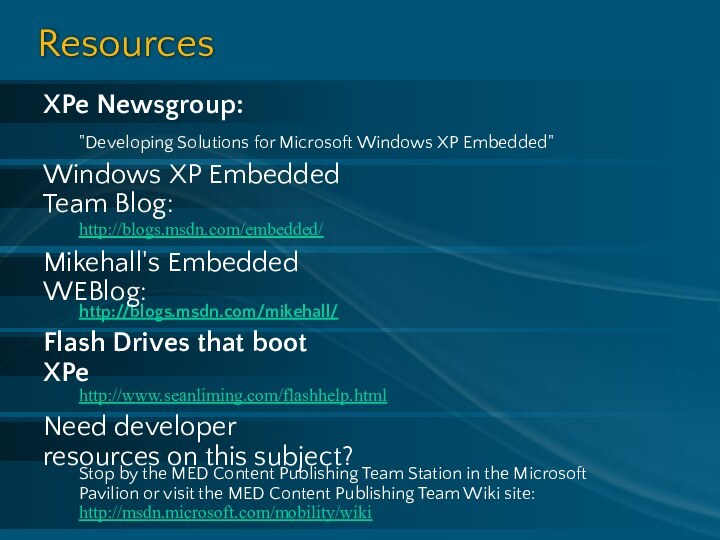

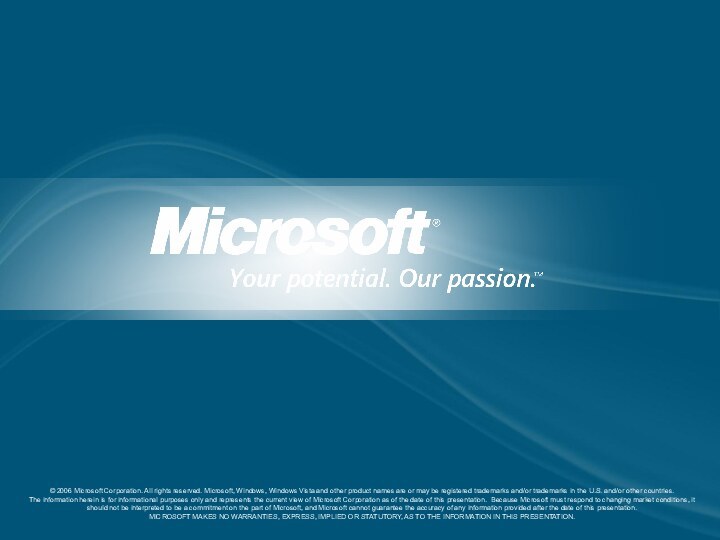
Слайд 2
Windows XP Embedded
Boot Options (Melbourne)
David Jones
RMIT University
Melbourne,
Victoria, Australia
Слайд 3
Agenda
Microsoft Windows XP Embedded Features
Creating an XP Embedded
Image
Boot up Overview
Windows XP Embedded
Boot Options
Booting from:
Hard drive
Compact
FlashOther devices:
Solid-state drives
CD-ROM
Network
Hibernated state
Boot Performance
Conclusions
Слайд 4
Windows XP Embedded
Boot Options
Can boot from a
variety of media
Including diskless systems
And even USB
As well
as CF and other Flash devices
Слайд 6
Thin Clients
Network Devices
Office
Automation
Kiosk/ATM
Game Platforms
Industrial
Automation
Retail Point of Sale
Set-Top
Box
Gateway/Media Store
What People Are Building Today
Слайд 7
Componentized version of Windows
XP Professional
Same binaries
as Windows XP Professional
Fully compatible protocols
Support for all Windows
Device DriversWithout modification/wrappers
Runs desktop Windows XP applications
Subject to resources, without modification
Full Win32 and Microsoft .NET API
.NET2
Embedded boot options
For example, from Compact Flash
Windows XP Embedded Service Pack 2: Security and boot options
Key features of Windows XP Embedded
Слайд 9 Robust diskless system but want to use existing
Windows XP-supported hardware peripherals
Windows XP Embedded uses same peripherals
as desktop Windows XPWindows XP Embedded can be booted from solid state devices. (For example, CF.)
Stateless system (always boots to the same state) with quick boot
Windows XP Embedded with CF and EWF (RAM Reg mode)
System of many stateless and diskless webpads
Windows XP Embedded with remote boot
Embedded device that runs desktop .NET applications and services
Windows XP Embedded runs same apps as desktop Windows XP
Some Windows XP Embedded Scenarios
Слайд 11
Microsoft Windows Embedded Tools-1
Target Analyser
Interrogates target system for
devices
Ta.exe, runs under DOS
Tap.exe, runs under XP
Can run on
existing desktop XP installation (best)Can run from PXE boot using first XPE CD
Component Designer
Imports output from target analyser to create platform component
Can also import XP device installation files
Component Database
Stored in SQL 2000/5
Слайд 12
Microsoft Windows Embedded Tools-2
Target Designer
Specify image
Which platform
Choose a
macro
Add other devices
Fine tune settings
Resolve dependencies
Can auto-resolve
Repeat until all
OK.Build Image
Generates image within file structure for deployment
Not a bound single file like nk.bin (CE)
Can create a single bound image file (.sdi)
Eg. Use for network boot
Слайд 13
Deployment
Suitably prepare target media
Create partition, set as active
partition, reboot and format
Copy XPE build files to media
Must
copy hidden/system files as wellCan insert media into dev. machine and copy, eg. CF
Can do network copy
Run First Boot Agent (FBA)
Completes the run-time image build process by running a sequence of tasks on the target system
Eg. Plug and Play device detection, security installation, and network configuration.
Can add commands to FBA and specify when they will run during the FBA process
Слайд 14
Creating an Windows XP
Embedded Image
David Jones
RMIT University
Melbourne, Victoria,
Australia
300: Developing Windows Embedded Devices
A quick look at the
Microsoft Windows Embedded Tools
Слайд 16
Boot Devices
Need to read boot information and code
Need to read operating system configuration and code
Both may
be same media or different
Flash
Compact Flash
USB
Memory Stick
uDoc
CD-ROM
El Torito
Electromechanical
Floppy
Hard drive
Solid State
Microdrive
DiskOnChip
Network
Remote boot
Слайд 17
Classifications of Boot Media
Read/Write vs. Read-only media
Typical
storage is read/write. For example, hard drive.
For Flash ROM/CF
with limited write cycles better to use as read-only, except for updates and occasional save stateFixed vs. Removable
Can the OS storage be removed?
Physically/electrically
Stateless vs. Stateful
Is it a requirement that the device boots to the same pristine state? (Stateless) That is, discard transient state at shutdown
Local vs. Remote media
OS on local storage
OR get it from network server
Need network ROM
Слайд 18
Read-write and Read-only Media
Read/write
Hard drive
Embedded Disk
uDoc
(Compact Flash)
Read-only Media
Compact
Flash
CD-ROM
Network
Слайд 19
Removable Vs. Fixed Media
Fixed Media:
Hard drive, solid-state hard
drive
Removable media
CF, USB Memory
Removable media
Can't be partitioned (with Windows
tools)Can't be made active partition disk
Hard to get to boot
CF can be marked as fixed and used as fixed in True IDE mode.
Слайд 21
Windows XP Embedded Boot Modes
Hard drive
Read/write
Overlays
HORM
.OR Diskless:
Solid State
Devices
Solid State Disk
Flash ROM
Compact Flash
USB
Bootable CD
Network
Слайд 22
Booting With Windows XP Embedded in 5 Seconds
Media
needs to be configured to boot using
boot.ini file
Boot
partition needs to be marked as activeBoot.ini points to boot partition and OS directory
Need operating systems files on boot media
Not a single binary file like nk.bin with Windows CE*
That is, no boot loader program
Created with directory structure in Microsoft Windows Embedded System build process
Can do xcopy of files (/s /h) to media if it can be placed on development system
* Or use SDI: Bind files into one file that then can be deployed and unpacked
System needs to be configured (that is, in BIOS) to boot from that media
Слайд 23
A Typical Boot.ini File
This will boot Windows XP
Embedded from partition 1 on hard drive(media) 0 with
OS files in \Windows[boot loader]
timeout=0
default=multi(0)disk(0)rdisk(0)partition(1)\WINDOWS
[operating systems]
multi(0)disk(0)rdisk(0)partition(1)\WINDOWS="Microsoft
Windows XP Embedded" /fastdetect
Слайд 24
Hard Drive: Read-write Mode
Can build a Windows XP
Embedded system to boot from hard drive on a
standard desktop systemIf it runs Windows XP it will boot Windows XP Embedded
Can multi-boot system to desktop Windows XP as well as Windows XP Embedded
TAP interrogation of system can be more thorough when done on an existing Windows XP desktop
Can build an Windows XP Embedded system in read-write HD mode on Virtual PC and VMWare emulators.
Can allow stateful system
All changes are preserved between boots
OR can use stateless
Disk Overlays (EWF Disk Mode)
Слайд 25
Enhanced Write Filter
(EWF) Overview
Protects a volume from
write access
Enables boot from read-only media such as CDROM
and flashCan save write cycles to other media where desirable:
CF, Network
EWF Overlay
Protects contents of volume from writes by redirecting to alternative media
Eg Read/write storage, RAM
Like a transparency overlay
Can be consolidated into the volume or discarded
EWF Volume
Stores static EWF information about the volume being protected
Not the transient overlay data
Can be on protected volume, in registry
Слайд 27
Disk Overlays
Read Only
Read Only
Read/Write by EWF
Changes to C
drive will appear to the OS as being to
C drive but will actually be written to EWF Disk OverlayCan have multiple overlays.
One active for write at
a time .
EWF Overlay 3
EWF Overlay 2
EWF Overlay 1
Local Disk
Слайд 28
RAM Overlay
When system is shutdown, overlay in RAM
is lost
Useful for stateless system
Can commit overlay to protected
volumeDisk must be partition-able
Not CF in removable mode, not CDROM
Single overlay only
Read Only
Read Only
Read/Write by EWF
Слайд 29
RAM Reg Overlay
EWF configuration is skipped in FBA
EWF
is added to registry after FBA and enabled
Useful:
Where
media is not partition-ableFor removable media such as CF, USB
Minimizing CF write cycles
Can commit Overlay to disk if it is writeable
Read Only
Read/Write by EWF
C:\
Partition 1
Protected Volume
EWF Overlay
EWF config info
stored in Registry
Registry
Disk
RAM
Слайд 30
Note on EWF API
There is an API for
programmatic use of EWF overlays
eg. Sample app:
http://msdn.microsoft.com/library/default.asp?url=/library/en-us/dnXPesp1/html/EWFAPI.asp
EWF API is
part of Windows XP Embedded install:Include EWF API Component in Windows XP Embedded build
Use EWFAPI.DLL, EWFAPI.LIB, EWFAPI.H in programming
EWFAPI.LIB on Windows XP Embedded SP2 is incorrect file
Update: (May 2003 Q818822):
http://msdn.microsoft.com/embedded/downloads/xp/impQFE/default.aspx
May also need Power Management API:
Shutdown, Restart, etc. functionality
XPEPM.LIB, XPEPM.DLL, XPEPM.H
In VALUEADD\MSFT\XPEPM folder on Disk 1
Слайд 31
Booting Windows XP
Embedded from a Hard Drive
David Jones
RMIT
University
Melbourne, Victoria, Australia
300: Developing Windows Embedded Devices
Demonstrate booting a
preconfigured Windows XP Embedded from a hard drive: with overlays.
Слайд 33
CF Types
Consumer Grade
Meant for use in consumer devices
as removable bulk
data storage
That is, cameras, PDAs, phones
300K
read-writesOEM
For use in embedded systems
Wear-levelling
Hardware algorithm than avoids continuous rewrites to same location.
Industrial grade
Wider temperature ranges
Consumer grade CF are less expensive
Слайд 34
CF Issues
Pros and Cons
?Solid state
? Robust
? Removable
? Can
be adapted for IDE (CF-IDE adapter)
? May need to
mark as non-removable in IDE mode? Need vendor utility
?Limited write cycles (300K)
? Wear-levelling in (some ?) OEM/Industrial grade CF
? Slower than diskonchip because of lack of DMA
SanDisk
SanDisk is inventor of CF
They provide consumer grade and OEM CF
Not industry grade CF (Temperature range aspect)
Flash Drives that boot Windows XP Embedded
http://www.seanliming.com/flashhelp.html
Слайд 35
Using CF in an Embedded System
CF has OS
so is read by CPU
Replaces hard disk of desktop
systemIssues:
Want to minimise writes to CF though
Marking CF as fixed
Need to get OS onto CF
USB CF Adapter
CF
In true
ID mode
CPU
IDE
Channel
CF to IDE Adapter
HD
Power
CF Pin 9
grounded
Слайд 36
True IDE Mode: Fixed Disk Mode
When pin 9
of CF is low it boot up the CF
enters a true IDE modeWith an adapter can be used in an IDE bus for storage (read/write)
Windows XP will not allow low-level formatting with non-fixed disks
fdisk and diskpart don't recognise it
So can't mark it as the active partition/disk
So can't boot from it with Windows XP Embedded
Need to mark the CF as fixed
Need a utility for that
Reversible
Note: CompactFlash ORG requires CFs to be delivered in removable mode
If using CF with single partition (RAM Reg mode) you may not need marked as fixed.
Слайд 37
CF Scenarios
Use an OEM/Industrial grade CF
Get utility from
CF manufacturer to mark CF as fixed
Confidentiality issues
If using,
Mode may not need to mark as fixed.Implement as storage device for operating system
Implement enhanced write filter to minimise (or totally inhibit) writes to CF
Wear levelling also with OEM/Industrial grade CFs
Provide embedded systems with CFs
Use Consumer grade CF
The utility will work with only some CFs
Even within same batch
OK for development/teaching purposes
Слайд 38 Booting from CF with Windows XP Embedded RAM
Reg Mode
Hardware needs
CF-IDE adapter
CF marked as fixed
CF-USB adapter
Key Windows
XP Embedded ComponentsEWF Manager
Enhanced Write Filter
EWF NTLDR
EWF Registry keys
Create as XPe component
Next slide
Other
Disable "Start EWF Enabled
Disable the FBA DLL/COM
Prepare CF as bootable drive
Boot with Windows XP Embedded Disk 1
Copy files to disk
Use CF-USB adapter on dev machine
Xcopy /s /h
Get hidden files
Boot and let FBA run
When finally booted run EWFMGR on device and see that EWF is running in RAM Reg mode
Слайд 39
EWF on CF Registry keys
Windows Registry Editor Version
5.00
[HKEY_LOCAL_MACHINE\SYSTEM\CurrentControlSet\Services\ewf]
"ErrorControl"=dword:00000001
"Group"="System Bus Extender"
"Start"=dword:00000000
"Type"=dword:00000001
[HKEY_LOCAL_MACHINE\SYSTEM\CurrentControlSet\Control\Class\
{71A27CDD-812A-11D0-BEC7-08002BE2092F}]
"UpperFilters"="Ewf"
[HKEY_LOCAL_MACHINE\SYSTEM\CurrentControlSet\Services\ewf\
Parameters]
[HKEY_LOCAL_MACHINE\SYSTEM\CurrentControlSet\Services\ewf\
Parameters\Protected]
[HKEY_LOCAL_MACHINE\SYSTEM\CurrentControlSet\Services\ewf\
Parameters\Protected\Volume0]
"VolumeID"="{1EA414D1-6760-4625-8CBE-4F9F85A48E15}"
"Type"=dword:00000001
"ArcName"="multi(0)disk(0)rdisk(0)partition(1)"
Слайд 40 Boot a device in RAM Reg mode from
CF
Booting Windows XP Embedded from CF
David Jones
RMIT University
Melbourne, Victoria,
Australia300: Developing Windows Embedded Devices
Слайд 42
Embedded Disks
Can have IDE interface
Plug in in place
of a hard drive
More robust than HD
Faster than CF
Can
be used as read-writeable HDNo need for overlays
No "set fixed mode" utility required
Rewrite 1 million +
10 MB/s read/write transfer rate
Lower capacity than CF
Слайд 43
Solid State Disk Demos
The previous Disk Overlay Demo
used an EmbedDisk.
The Hibernate Once Resume Many Demo also
uses and EmbedDisk
Слайд 44
USB
Many embedded SBC only have USB 1.1
Not fast
enough for boot process
Must have USB 2
USB (2) Memory
sticks are in not suitable XPe boot devicesUSB is enabled late in boot process
USB devices are not fixed
M-Systems solution:
uDoc
Слайд 45
USB: M-Systems uDoc
M-Systems uDoc (USB DiskOnChip)
Windows XP Embedded
can be configured to boot from this
Loads early in
boot processCan be connected to USB socket on board
No need for EWF
Wear levelling technology
http://www.m-sys.com/site/en-US/Products/M-Module/M-Module/Products_/uDiskOnChip.htm
Easy to transfer image files (USB host adapter for module)
USB 2.0 Boot must be supported in BIOS
See: 300 Building Windows XP Embedded Devices for USB Boot
Слайд 46
Windows XP Embedded CD-ROM Boot
Use RAM Reg mode
Develop
El Torito Bootable CD-ROM
CD-ROM appears to be writeable via
overlay in RAMConfigure system to boot from CDROM
Слайд 47
Booting From CD-ROM
Slower boot than solid state
Easy deployment/update
to multiple systems
System integrity
Can use hard disk-less system
General slow
depending upon image size and CD-ROM speedUseful as a system tool
Слайд 48
Create image
Need EWF components
NTLDR, Registry, Management console
Need CDFS
Need
El Torito Component
Some others needed
Place HD and CDROM in
IDE channel 1FBA on target as <500M hard drive partition
Need an El-Torito CD in drive during FBA
Have 2nd partition for ISO image (900M)
Swap the HD and CDROM drive letters
Run ETPrep
Generate Boot CD ISO
Reboot with Windows XP Embedded CD1 into PXE
Create ISO file
Run HD2ISO
Copy ISO file to development machine
Burn CD
Remove HD
Place CD in target and boot
CD-ROM Boot: How To
Слайд 49
Using a pre-existing image
Booting Windows XP Embedded from
CD-ROM
David Jones
RMIT University
Melbourne, Victoria, Australia
300: Developing Windows Embedded Devices
Слайд 50
Windows XP Embedded HORM Boot
Hibernate Once Resume Many
Resume
from same hibernated state
Quick boot
Stateless system
Normally when Windows boots,
the state information in the hibernation file is deleted by zeroing out the first page of the hibernation file However, by using EWF, you can persist that state information from boot to boot
Reuse the same hibernated state
Слайд 51
Booting from HORM
Fast boot of system to known
state
Easily extended/updated
Disable HORM
Reboot and add changes
Recapture
Adds robustness to system
Adds
securityUse EWF with Hibernation:
Develop EWF system
Boot
Run required applications without closing
Hibernate
Persist same hibernation state after boot
Normally deleted
Volume remains protected
Слайд 52
HORM Boot: How to
Create image. Needs
EWF:
RAM Overlay Mode,
API, NTLDR, Management Console
Power Management
Computers
One of: ACPI PC,
Standard PC, ACPI UniprocessorSetting: Enable hibernation
Must have target's specific video driver
Build image
Create and place a file:
resmany.dat in root
Tells EWF that this is a HORM setup
Enables reuse of same hiberfile.sys file.
Check that hiberfile.sys is in root
dir /Ahs c:\hiberfil.sys
Use EWFMGR and XPEPM to manage HORM:
Enable EWF
EWFMGR c: -enable
To see status
EWFMGR c :
Hibernate system and enable HORM
XPEPM –Hibernate
Reboot system from hibernation
Can shutdown and restart to same state.
XPEPM –shutdown / -restart
Can commit changes to HD
EWFMGR c: -commit
Can commit and stop HORM
EWFMGR c: -commitanddisable -live
Слайд 53
HORM: Key Issue
This uses Power Management component
That only
works if you have the correct hardware drivers
Some things
are missed by TAP via PXECan get by with other boot configurations but not with Power Management
Need the correct Windows XP Video driver
Need various BUS drivers
Ref: "Troubleshooting Windows XP Embedded's blue screen "Stop 0x0000007B" error", Sean Liming
http://www.windowsfordevices.com/articles/AT6380158626.html
Слайд 54
HORM: Hibernate Once Read Many
Booting a Windows XP
Embedded HORM Image
David Jones
RMIT University
Melbourne, Victoria, Australia
300: Developing Windows
Embedded Devices
Слайд 55
Windows XP Embedded (REMOTE) Network Boot
Boot with device
PXE
Preboot eXecution Environment
Image downloaded to RAM from PXE server
Uses
TFTPOS then boots from RAM Disk
No persist storage required:
Diskless system
Requirements:
About double normal RAM
PXE compatible BIOS and Network card
Remote boot PXE server
DHCP, PXE, TFTP
Слайд 56
Remote Boot
Create a Windows XP Embedded image file
(post FBA)
Deploy that to a server
Install RBS on Windows
Server from Windows XP Embedded disk 2With DHCP
Target PXE (network) boots.
On getting DHCP response RBS uses MAC address to determine which image to return.
Note: Needs RAM 2 x image size
Image file gets downloaded to ram and system is generated from there.
Слайд 57
Remote Boot: How to
Create image and run FBA
No
special components
Use HD system on target
Create .SDI file from
booted imageInstall Microsoft Windows Embedded Remote Boot Manager
On a Windows 2003 Server
With DHCP on the Server
Some Remote Boot Server-DHCP configuring
Configure boot
Place .SDI file on RBS
Configure PXE boot based upon MAC address
Enable Network boot on target and boot
Слайд 59
HORM: Hibernate Once Read Many
Remote Booting of a
Windows XP Embedded image
David Jones
RMIT University
Melbourne, Victoria, Australia
300: Developing
Windows Embedded Devices
Слайд 61
Usability
How much boot time will users suffer?
CF boots
in about 1 minute
Other non CD boots < 1
minuteNetwork would depend upon many factors
Generally up to one minute to boot is suitable for most scenarios
For example, POS at start of day.
If stateless system goes down, can bring back up in pristine state within one minute
Enable Standby for more frequent power downs
Слайд 63
Conclusions
Windows XP Embedded can be booted from a
variety of media
Besides using a standard hard drive, it
can be booted from a CD-ROM and solid state media such as Compact Flash and Flash drivesSolid state boot media make the system physically more robust
Windows XP Embedded can be booted from read-only media which has significant reliability and security benefits
Windows XP Embedded systems can also be booted from a saved hibernation state which facilitates fast boot up
Network boot of Windows XP Embedded facilitates a network of diskless systems to be used
Слайд 64
Resources
http://www.microsoft.com/communities/newsgroups/en-us/default.aspx
Search for "Windows XP Embedded" "General Discussion"
MSDN
Training Course 2545C:
Windows XP Embedded Step by Step, Beau Cseri,
Annabooks/Rtc Books
January 2003 Windows XP Embedded Advanced , Sean D. Liming,
Annabooks/Rtc Books, October 2003 Some Books (Search on web):
http://msdn.microsoft.com/embedded/windowsXPembedded
/default.aspx
MSDN-Embedded-XPe Website:
http://msdn.microsoft.com/library/default.asp?url=/library/en-us/dnanchor/
html/XPembedded.asp
MSDN Library:
Слайд 65
Resources
"Developing Solutions for Microsoft Windows XP Embedded"
XPe Newsgroup:
http://blogs.msdn.com/embedded/
Windows
XP Embedded Team Blog:
http://blogs.msdn.com/mikehall/
Mikehall's Embedded WEBlog:
http://www.seanliming.com/flashhelp.html
Flash Drives that boot
XPeStop by the MED Content Publishing Team Station in the Microsoft
Pavilion or visit the MED Content Publishing Team Wiki site:
http://msdn.microsoft.com/mobility/wiki
Need developer resources on this subject?

